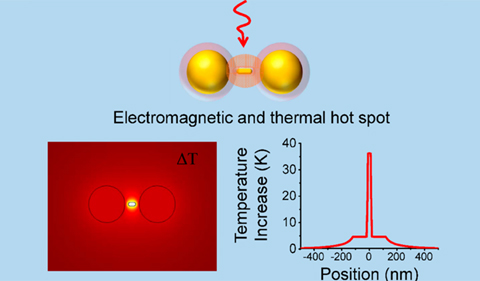
By Amanda Biederman
NQPI editorial intern
When heating objects at the nanoscale, many researchers face problems of precision, efficiency and control of the process.
Ohio University Physics & Astronomy Distinguished Professor of Physics and Nanoscale and Quantum Phenomena Institute member Dr. Alexander Govorov is helping other researchers to better understand this issue. His group uses mathematical modeling to describe how nanoparticles generate heat under different conditions.
Govorov’s group currently consists of three members: post-doctoral fellows Lucas Vazquez-Besteiro and Xiang-Tian Kong, and Ph.D. student Larousse Khorashad. They are working collaboratively on various topics related to nanostructures, heat generation and optical energy.
“We provide a recipe for the experimentalists, so that they don’t have to rely on trial and error,” Khorashad said. “We do not necessarily need to spend a lot of time and money on experiments. Rather, using theoretical and computational tools, we model the physics of nanostructures based upon realistic approaches for our theoretically informed designs.”
Govorov’s group recently reported a unique particle arrangement that allows for efficient, localized nanoscale heating. They described a system consisting of two large nanoparticles surrounding a small nanorod. The larger bodies act as antennas that enhance excitation in the center, resulting in a concentrated central “hot spot.”
Nanoscale heating is achieved by harnessing light energy. First, a nanoparticle is excited by a light beam. A high-energy electrical field is generated, and part of the energy is converted to heat. The amount of heat generated is dependent on the geometry of the nanoparticle, as well as the material used and the light intensity.
This technique has several biological and technological applications. For example, by localizing light energy in the proximity of biomolecules such as DNA, scientists can better understand their structures. Additionally, localized heating can be used for the controlled enhancement of chemical reactions. Further, localized temperature control is critical in small electronics.
“By controlling particles’ shapes, we can tailor their optical properties,” said Vazquez-Besteiro said. “This underlies most of our work.”
Govorov’s group collaborates with several experimental scientists, including Chemistry and Biochemistry professor and NQPI member Dr. Hugh Richardson and Vanderbilt University Electrical and Mechanical Engineering professor Jason Valentine, whose group fabricates different nanoscale systems.
By presenting their work alongside experimental data, Govorov’s team is helping experimentalists optimize their strategies in nanoscale heating and predict new physical effects and applications.



















Comments